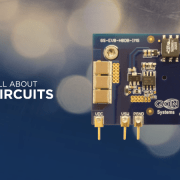Article: How GaN Is on the Fast Track for 2021
Jake Hertz interviews GaN Systems CEO Jim Witham for All About Circuits. Read the full piece here from December 19, 2020.
2020 ushered in a wave of GaN transistors in applications from automobiles to audio amplifiers. We talked with GaN Systems CEO Jim Witham to find out why he thinks 2021 could see even more GaN adoption.
While gallium nitride (GaN) transistors were once the musings of university research projects 20 years ago, these devices are now widely adopted across the industry—especially in 2020.
GaN transistors are now a popular substitute for silicon-based FETs because they offer extremely high electron mobility. This also gives GaN a leg up with smaller on-resistances and significantly faster switching speeds than silicon-based transistors.
GaN transistors are driven in the same way as conventional MOSFETs, making them easy to integrate into existing designs. This is partly why 2020 marked a market high of GaN acceptance with more power supplies, audio amplifiers, data centers, and automotive systems implementing GaN than ever before.
All About Circuits had the privilege of speaking with Jim Witham, the CEO of GaN Systems, (who we also interviewed back in 2018) to hear his predictions on the future of GaN and why 2021 might push this technology even further into ubiquity.
Medium Voltages: GaN’s Sweet Spot
To begin, it seems that GaN has hit its stride in a number of key industries, from fast chargers to data centers. While GaN isn’t the solution to every power application, its “sweet spot,” according to Witham falls in the 60 V to 1200 V range.
“Silicon works for low voltages (60 V and below) and low power, GaN is ideal for medium voltages (60–1200 V) and medium power, and SiC and IGBTs suit high voltages (1200 V and above) and high power,” he observes.
Chargers and Adapters
One market that saw widespread GaN adoption in 2020 was the charger and adapter market for applications like phones, tablets, and handheld gaming devices.
An immediate reason for this demand was the widespread push for fast charging, particularly from Asia-based manufacturers. Faster charging requires higher power levels, which often means bulkier equipment. GaN fills this market need with smaller chargers and higher power levels.
“In particular, Huawei, Oppo, and Xiaomi are all really pushing fast charge,” says Witham. GaN Systems predicts that 2021 will see other big-name brands start to bring their own GaN chargers to market, too, as GaN becomes an industry standard.
Audio
During our conversation, Witham recounted his experience in a “sound off” between a silicon amplifier and a GaN amplifier. At first, he was concerned the difference wouldn’t be notable. “Man, it is so easy [to hear the difference],” he remarked. “You close your eyes and you think you’re hearing a live concert.”
Growing demand for small, high-quality audio devices at low power has made the Class D audio amplifier a fan favorite for designers. Relying on a MOSFET output stage, the Class D amplifier relies on the fast switching speed of these transistors to accurately recreate the audio waveforms.
This is another place where GaN outpaces silicon thanks to its extremely high switching speeds, sometimes up to 1,000 times faster than silicon-based FETs. A whitepaper from GaN Systems quantifies this superior audio quality, showing that a GaN-based Class D amplifier can produce a total harmonic distortion (THD) as low as 0.004% compared to 0.015% for a silicon product.
Witham comments, “I have audio guys tell me, ‘You’re as close to the perfect transistor as I think we’ll ever get.’” Because of decreased size and superior audio quality, GaN Systems predicts that a significant number of the world’s noteworthy audio brands will be producing GaN-based amplifiers in the coming year.
Read the rest of the interview here at All About Circuits.




